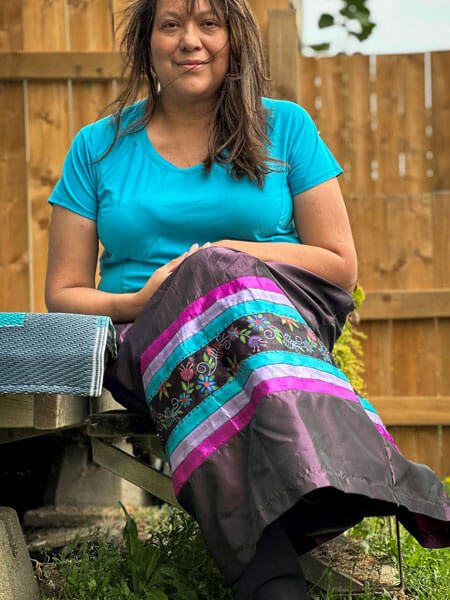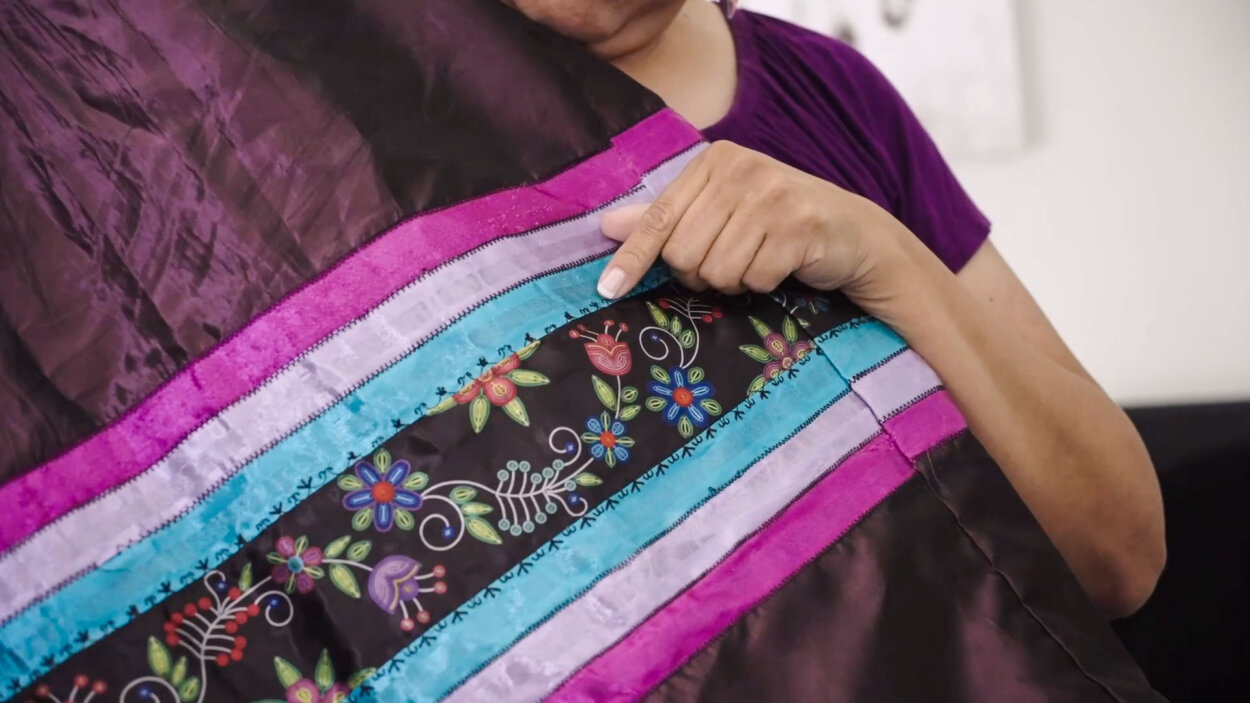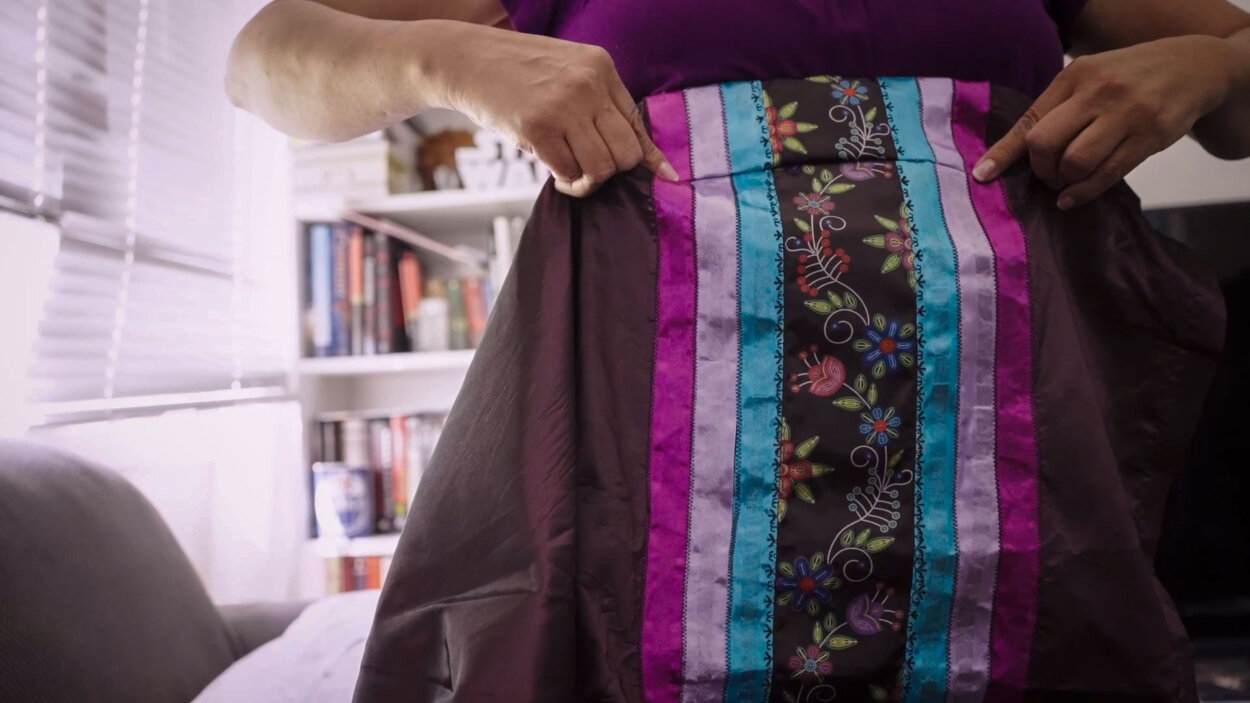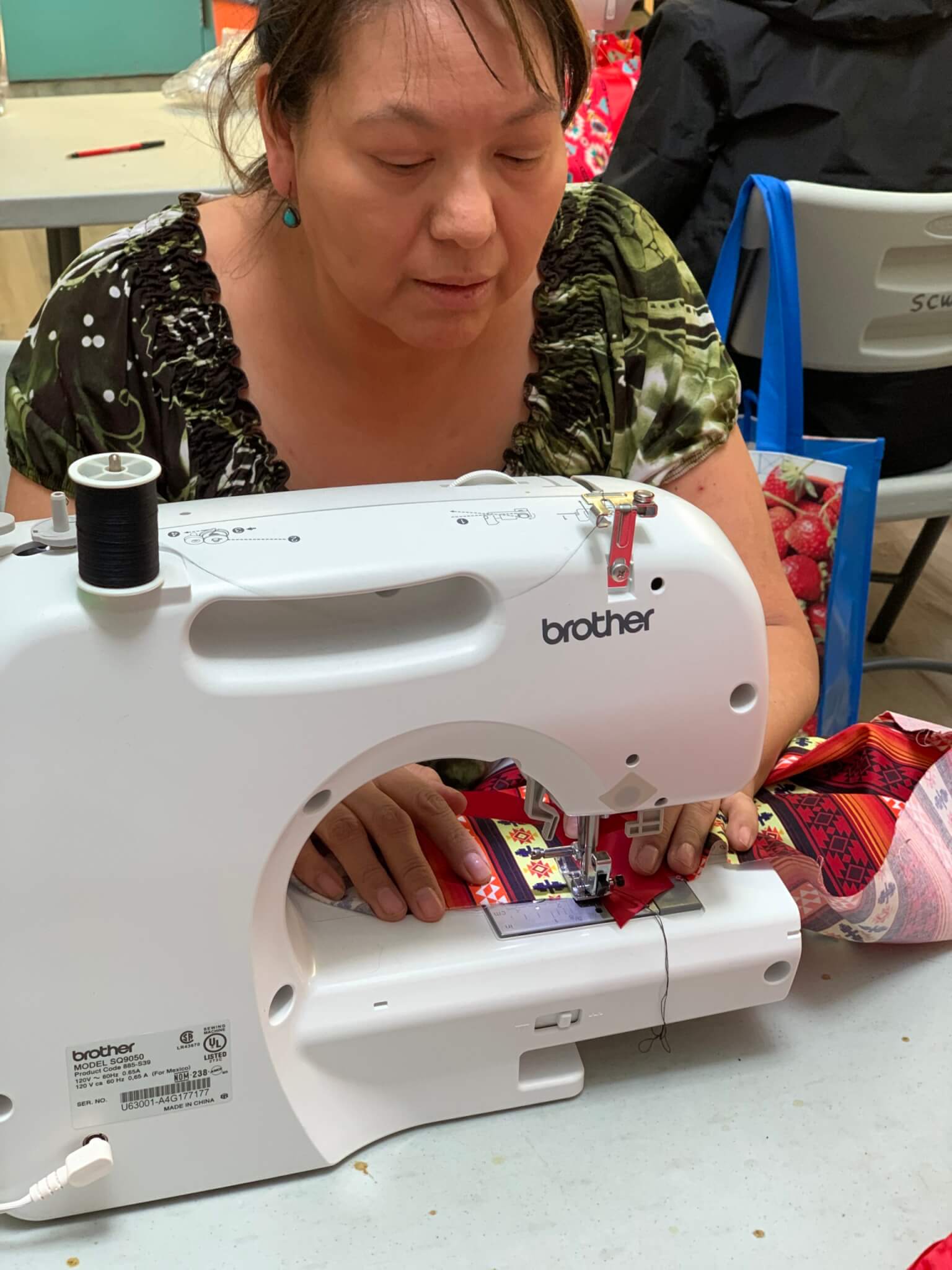Athabasca University student's Master of Science in Information Systems thesis blends virtual reality with centuries-old cultural practices
You might not expect someone to do a sewing project for their master's thesis in a computing program… but this isn't your average sewing project.
Twylla Soosay is a student in Athabasca University's Master of Science in Information Systems program and member of the Samson Cree Nation. She's bringing together her computer skills, her experience as an educator, and her Cree background for her thesis work, which will help teach cultural traditions to a new generation.
Her project, Creation and Investigation of Virtual Spaces for Community Learning and Sharing, involves creating a virtual reality (VR) experience that will teach people how to make a ribbon skirt, which is an important garment in Cree culture. In this way, students could put on a VR headset to get an immersive first-person view of how to make a ribbon skirt, with the voice of a teacher guiding their learning.
This was partly inspired by Soosay's own efforts to reconnect more with Cree culture, which she said wasn't a significant part of her own family's experience while she was growing up in Maskwacis, Alta. She knew ribbon skirts were important, and as an adult wanted to learn how to make one but found it difficult to find resources.
"I tried to ask people can you send me instructions, and they're just like, 'Well, maybe you could just watch me,'" she said. "They don't have anything written down. Everything is visual."
Virtual reality project a tool for Indigenous education
Soosay said ribbon skirts are an important piece of cultural clothing in the Cree culture. Beyond the practical uses as a garment, they have a deeper meaning in Ceremony and help connect Cree people to the Earth. She thought this would make an interesting project that blends her interests into a master's thesis that helps her to reach her learning goals-both academic and otherwise.
Because of her background as an educator working with Cree students, including students with a wide variety of learning abilities and styles, Soosay said there's huge potential for a virtual reality lesson about Cree culture without the distractions that come from a more typical learning environment.
 "When I did the literature review, I found that when you cover everything else, when you're not being distracted by anything because you have the goggles right on your eyes, you're totally immersed," she said.
"When I did the literature review, I found that when you cover everything else, when you're not being distracted by anything because you have the goggles right on your eyes, you're totally immersed," she said.
Putting idea into action
While the project's cultural components were inspired by her desire to learn more about Cree culture, the technical side was inspired by her own personal interests in science fiction, gaming, technology, and filmmaking.
The thesis work began by reviewing existing academic literature over winter 2022-23, in which Soosay read as much as she could about the potential for 360-degree video technology and how it can be used, and then moved on to the technical aspects.
"I did the literature review, and now I'm doing the actual camera work with virtual reality. I'm learning how to do a 360-degree video and load it into Adobe Premiere Pro," she said.
The logistics of working with the technology have also another learning opportunity. Figuring out where to set the cameras to create a first-person perspective, without having the camera in the way of the work she's doing, has been a challenge.
Bringing Indigenous culture and experience into a Master of Science thesis
Soosay's educational and career journey has had several stops before ultimately leading up to her taking the Master of Science in Information Systems program at AU, and she draws on many different sources for inspiration for this ribbon skirt project.
She completed an undergraduate education degree, focused on math and social studies, from the University of Alberta. She spent several years teaching at both the Maskwacis Cultural College and at a local high school.
After several years, she changed direction in her career and earned a 1-year college diploma focused on electronics and computer technology and spent close to a decade in IT oversight and management position before being laid off.
It's good to give the kids something they can learn that they're proud of. I spoke with the sewing teacher at the high school, and she said watching the kids making something for themselves, makes them proud of not just themselves, but proud of being Cree.
Twylla Soosay


A flexible graduate degree in an Indigenous community
At the start of the COVID-19 pandemic, Soosay decided to continue her education and pursue a master's degree. One of the advantages to the AU Master of Science in Information Systems, for Soosay, is the flexible delivery. Being able to stay in her home community with her family has been inspiring in many ways.
For example, the experience of simply being in the home and working has made her realize the opportunities for authentic cultural representation in this project, right down to some of the little details, like including the sounds of women talking and children playing as part of the background noise in the immersive virtual reality lesson she's creating.
"That's basically how a Native household is. It's organized chaos. Everybody's running around, doing their own thing, and we're all having fun and laughing at the same time," she said. "I figured that would be a good to use that audio, kind of muffled noise in the background while I'm sewing."
Education to (re)connect with Indigenous culture
Soosay said accurately reflecting different elements of Cree culture in this project is important to her because she has not always felt rooted in her culture in the same way some of her peers have.
Her family did not actively participate in cultural events like Powwows and other ceremonies. Her father, who was Cree, left the family when she was young. In his youth, he attended the Ermineskin Indian Residential School. Her mother, who grew up in the Tsuut'ina Nation near Calgary, Alta., attended a day school and was likewise disconnected from her roots.
"My mom never knew her culture and never knew her language. And my dad was told as a kid that he couldn't speak his language," she said. "It affected not just them, but it affected their children and their children's children."
"So that was part of my goal, being able to learn something that I can do that's cultural."

Applying her research to Indigenous education
Being an educator as well as a lifelong learner, Soosay said she's also focused on the benefit this kind of project can bring to others in her community. As the title of her thesis implies, her work is not just about creating a virtual reality experience, but also about it being an asset that can promote cultural learning and sharing within her community.
And this benefit can be especially poignant for others who, like her, who have struggled with learning and understanding what it means to be Cree. Her experience working in the local high school as brought this potential benefit for students sharply into focus-being aware of and developing pride in Cree culture.
"It's good to give the kids something they can learn that they're proud of," she said. "I spoke with the sewing teacher at the high school, and she said watching the kids making something for themselves, makes them proud of not just themselves, but proud of being Cree."
Graduate Student Research Fund
While Soosay already had some of the technology she needed to complete the project, the cost of the remaining components she needed had presented a potential barrier. She was able to easily overcome this with funding from AU's Graduate Student Research Fund.
That funding helped her to purchase camera equipment and to provide an honorarium to the Elder who is helping provide the ribbon-skirt-making instructions for the project.